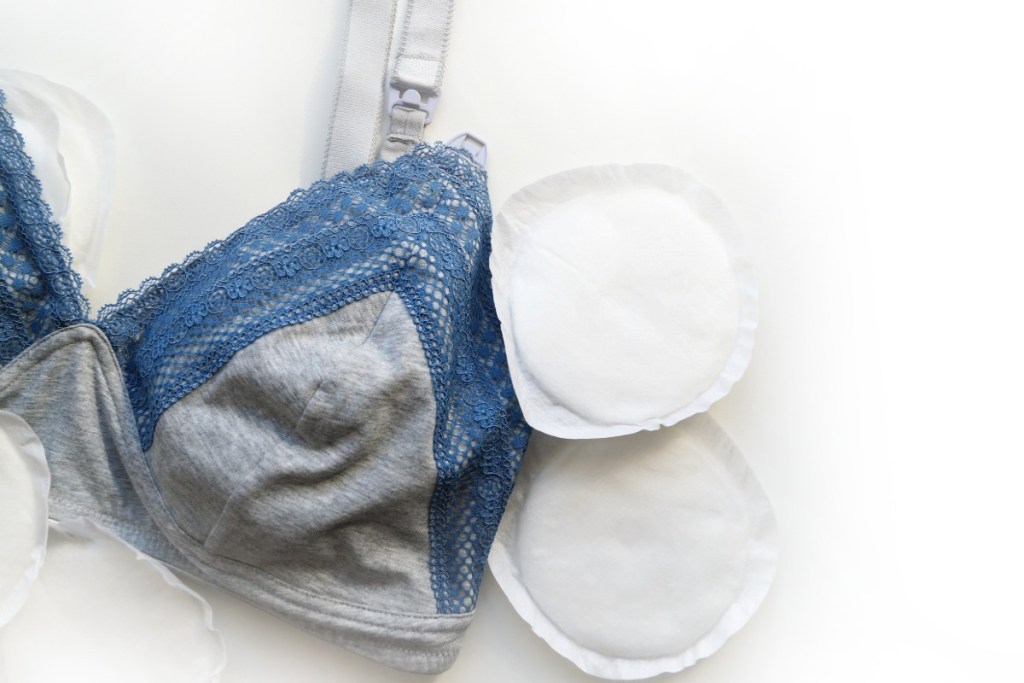One of the early joys of breastfeeding: Leaky boobs. Yep, you may be strolling with your newborn baby through the neighborhood or going back to work for the first time since maternity leave when — lo and behold — you’ve got a wet patch right over one nipple — or both. It can feel embarrassing in the moment, but it’s totally natural (and, trust us when we say that all nursing moms have been there and empathize with this struggle!).
Still, you can try to avoid having your own postpartum wet T-shirt contest with the help of nursing pads. They slip in between your breast and bra to absorb a little bit of that inadvertent leakage. There are two types of pads: Disposable options and reusable or washable ones. They both come with their own sets of pros and cons, and you’ll want to evaluate which is right for you.

Disposable nursing pads
One and done? Here is what you need to know when choosing throwaway nursing pads:
Disposable pads have a variety of absorbency levels
The best nursing pads are the ones that keep you dry. To that end, most disposable nursing pads offer great absorbency. They are effective at collecting some spillage, if you will, and allowing you to go about your day without worry. Fewer leaks mean more confidence — so you can be out and about without obsessively checking your top.
These pads from Lansinoh have an absorbent core and a waterproof lining to keep you feeling (and looking) dry.
Also, note that disposable options may come in a variety of absorbency levels. Once you’re out of that early nursing stage, you may be less prone to leakage, and you’ll be able to graduate to a thinner option, like these pads from Medela.
Disposable pads are not the most comfortable fit, but they do stay put
While they’re certainly not uncomfortable, disposable pads are not exactly buttery soft. Some women find them slightly abrasive on the sensitive nipple. However, on the other hand, many women appreciate that they feature an adhesive to stick to your bra — so they won’t shift or move.
Disposable pads are highly convenient
When you’re on the go, disposable nursing pads are super convenient. They generally come individually wrapped — so you can keep one or two in your diaper bag or purse and go about your business. What’s more, if you experience significant leakage, you can throw the one you’re using out and simply replace it. It’s that easy and effortless.
Buying disposable pads can get expensive
Since you’ll be chucking them after each use, you’ll constantly need to refresh your supply of disposable nursing pads. This can add up and become expensive. On the other hand, once you’re out of the early stage of breastfeeding, your milk supply will regulate, and you won’t experience as many unexpected leaking incidents — so your stream of pad use will also steadily decrease.
Buying disposable pads isn’t very eco-friendly
Of course, a disposable option that needs to be replenished has more of an impact on your carbon footprint. If you are trying to live a little greener and embrace a more eco-conscious stance, you may want to avoid using these options on a regular basis.
Reusable nursing pads
Wear, wash, repeat. Here are some things to consider when choosing reusable options:
Reusable pads may not be as absorbent, but they’re not as noticeable
Reusable pads offer a fair amount of absorbency, but because they are generally thinner and made of fabric, they might hold a little less liquid than their disposable counterparts. On the other hand, they may look more even and discreet under tight-fitting clothes.
Reusable pads are super comfortable
Soft and smooth, reusable options feel silkier and more natural on bare nipple skin. They are generally contoured for a secure fit, but unlike disposable ones, they won’t adhere to your bra.
These pads from Bamboobies are made with a delicate blend of bamboo, cotton, and other materials for top-notch comfort on Mom’s sensitive skin.
Using reusable pads requires a bit more planning and time
If convenience is a top priority for you, then washable options might not be your thing. We’re sure that laundry is already piling up with a newbie at home, so if you’d rather avoid adding more to your piles, disposables may be the way to go.
What’s more, these are not quite as easy to use on the go. You’ll want to pack them in a clean diaper bag pocket or, better yet, house them in Ziplock baggie. You may need to switch them out more often if you’ll be away from home for a while.
Reusable pads are cost-effective
You can purchase just a few reusable pads and rotate them throughout the week — as long as you can stay on top of your laundry. To this end, these options are much more cost-effective.
Reusable pads are great for the environment
Less waste, less guilt. With reusable, washable nursing pads, you are doing your best to take care of yourself, your baby, and Mother Nature.
Other considerations
Still can’t decide between the two? Here are a few more tips to note:
- It’s not all or nothing: Guess what? You can have it both ways. You don’t have to choose between reusable and disposable nursing pads. You can try both or use them for different occasions. Staying home with the babe? Pop in that super-comfy washable option. Heading out for a full day of errands? Now is the time to swap out and use a disposable.
- Take breast size into consideration: When choosing a disposable or reusable nursing pad, be sure to find one that will accommodate your breasts. While it’s most important that it covers the nipple area, bigger-chested women might feel more comfortable and protected in one that offers more coverage.
- Stick with nude, white, or black: When it comes to nursing pads, function trumps fashion. Avoid patterns and other designs; you need something practical that won’t be visible under all your blouses and tops.
- Cooling pads: In addition to absorbent nursing pads, you might consider gel or cooling pads for the early day of breastfeeding. While they won’t stop the flow, they will help to soothe and calm inflamed nipples. These Ameda ComfortGel pads help with soreness resulting from latching problems.
The best nipple pads will keep you feeling comfortable and confident throughout the day. Try some disposable ones, give some reusable options a chance, and see what works for your lifestyle. Either way, if a little leak does happen — with or without a pad in place — take a deep breath; it’s a fact of #momlife. And always be prepared with a change of shirt or a cardigan when you’re on the go.


